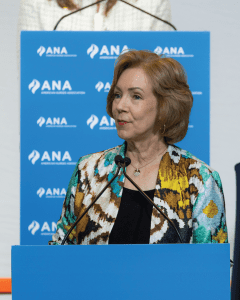RNs take bold action to address evolving nursing issues
More than 350 RNs from across the country came together for the 2023 American Nurses Association (ANA) Membership Assembly, the governing and official voting body of ANA, held June 16-17 in Washington, DC. Assembly representatives shared their viewpoints on and experience with urgent issues—including gun violence, virtual nursing, and the burden of nursing documentation—and acted on policy measures to address them.
The Assembly comprises representatives from ANA’s constituent and state nurses associations (C/SNAs), the Individual Member Division (IMD), and specialty nursing organizational affiliates (OAs), as well as the ANA Board of Directors. Eligible voting representatives elected national leaders to serve on the Board of Directors and the Nominations and Elections
Committee.


In the first Membership Assembly address of her term, ANA President Jennifer Mensik Kennedy, PhD, MBA, RN, NEA-BC, FAAN, spoke on the significance of the governance meeting as the way ANA members “ensure our policies, our programs, and our activism reflect and do justice to the [more than 5 million registered nurses] whose interests we represent.”
“The reason ANA is respected and taken seriously by policymakers is that they know our positions on issues are deeply held, deeply felt, and carefully considered by dedicated professionals with real experience up and down the line,” she said.
Focus on nurse staffing
Mensik Kennedy reflected on nursing issues that the COVID-19 pandemic pushed to the forefront and noted that many challenges need urgent attention. “Nurse staffing was a huge problem before the pandemic and the crisis is still with us,” she said.
At last year’s meeting, representatives approved a recommendation that ANA support safe patient standards, including enforceable ratios that are acuity and setting-specific as per nursing assessment, and that ANA engage with C/SNAs to develop further details regarding standards, implementation, and enforcement. Assembly representatives also called on ANA to collaborate with C/SNAs and OAs to begin developing evidence-based staffing standards for all nursing disciplines for publication.
Mensik Kennedy acknowledged that these recommendations marked a departure from ANA’s previous position, which argued against the use of staffing ratios.
“I recognize that the shift from ANA’s long-held policy opposing mandated minimum nurse-to-patient ratios to our current position is difficult for many of us,” she said. “I have wrestled with reconciling this change with my beliefs about how staffing decisions should optimally be made, along with my previous public comments opposing ratios.”
But this shift is necessary, she said, because employers are not taking meaningful action to address the nurse staffing crisis—which is only getting worse.
“Now is the time to act,” Mensik Kennedy said. “And to recognize that to change long-held positions and beliefs takes openness to others’ experience and courage. Like many others who are pursuing real, structural changes, now is a time to be courageous.”
Increasing visibility—and reckoning with the past
Mensik Kennedy urged nurses to get a National Provider Identifier (NPI) to demonstrate the value of nursing by making it more visible in hospital data.
Although RNs don’t bill for services, she said, NPIs make it possible to track the work that nurses do—the crucial first step in changing how healthcare systems and other practitioners view nurses and professional nursing care.
She acknowledged progress made since the ANA Racial Reckoning Statement was adopted at the 2022 Membership Assembly (nursingworld.org/RacialReckoningStatement).
“We have been intentional and diligent to make sure that the words in that statement will carry forth into action,” she said. “We made comprehensive diversity, equity, and inclusion work a priority in the ANA Enterprise strategic plan and have funded the ongoing work of the National Commission to Address Racism in Nursing.”
Noting the knowledge, wisdom, and insights that nurses bring to uplifting the profession, Mensik Kennedy said that her goal as ANA president is to empower all nurses to see themselves as leaders.
The value of nurses’ expertise
In her report, Debbie Hatmaker, PhD, RN, FAAN, chief nursing officer of the ANA Enterprise, applauded the advocacy that has been vital to advancing nursing’s priorities and thanked the nearly 400 participants in ANA Hill Day on June 15 (see Nurses take pivotal issues to Capitol Hill).
“Legislators and their staff, those who work in the White House and in key agencies, and other policymakers, need to hear from nurses often—so they can do the right thing,” she said.


“Doing the right thing means improving Occupational Safety and Health Administration standards so that employers will do more to protect their employees from workplace violence,” Hatmaker said. “It also means permanently removing practice barriers so that APRNs can contribute fully and increase access to care.”
Hatmaker provided an update on last year’s policy recommendations addressing nurse staffing, workplace violence, and the impact of climate change on health. The Nurse Staffing Task Force report (tinyurl.com/yc6jpdy9), along with the 2022 Nurse Staffing Think Tank report, provides a comprehensive series of recommendations specific to nurse staffing. She thanked the individuals for their dedicated efforts on this work.
After last year’s action by the Membership Assembly, which resulted in a policy to bring a greater focus on verbal abuse of nurses and ensure that this issue is addressed in workplace violence policies, ANA has focused on data collection and finding opportunities for collaboration. The public comment period on the proposed position statement, The Nurse’s Role in Addressing Global Climate Change and Human Health, concluded in June. A final version is expected this summer.
“Our advantage as nurses is that we are used to viewing situations from a holistic perspective,” Hatmaker said. “Let’s continue to leverage that in our efforts to create a healthier and safer country—and a better world.”


Action on key issues
In a dialogue forum on promoting gun safety and preventing violence, Assembly representatives discussed the devastating impact of this issue across society. Nurses spoke not only of the physical and mental health consequences of gun violence to those directly injured but also to the mental health and emotional effects on nurses, other healthcare professionals, first responders, and communities. Consequently, the Assembly approved these recommendations:
- Advocate for meaningful legislation to address gun safety and firearm access and increase funding allocated toward mental health services and gun violence and prevention research, including gun violence against healthcare workers in healthcare settings.
- Endorse the American Academy of Nursing’s Statement on Firearm Safety and Violence Prevention and update ANA’s position statement, Incivility, Bullying, and Workplace Violence, to include gun violence and prevention in healthcare settings.
- Promote nursing knowledge on the relationship between gun violence and public health, the risk factors of and protective factors against violence, evidence-based strategies to prevent violence, and the role of nurses in promoting gun safety and preventing violence, especially among children, adolescents, and young adults.
In recognition of the burgeoning role of virtual nursing, Assembly representatives voted to develop a national policy that addresses standardization of virtual nursing practice as a modality and considers funding and reimbursement models, as well as implications associated with licensure, regulation, and liability. In addition, the Assembly called for advocacy for technology that meets nurse and patient needs and to support data collection on virtual nursing to understand its impact on nurse and patient satisfaction, as well as patient outcomes. ANA recognizes virtual nursing as a source of support for nurses at the point of care. Virtual nurses should support, but not supplant nursing staff in nursing ratios, matrices, or other measures of staffing levels.
The COVID-19 pandemic highlighted the need to reduce the burden of nursing documentation, especially during a time of crisis. The Assembly approved recommendations to generate a national consensus for research and policy development to ease this burden, particularly during a crisis or emergency using an all-hazards approach. In addition, the Assembly approved partnering with regulatory agencies and stakeholders to review current documentation standards and revise policies that reflect a national standard for crisis documentation, specifically for nursing. Finally, the Assembly recommended involving experts on nursing professional liability and state regulation to ensure that revised standards of documentation don’t expose nurses to additional legal or regulatory risk.
The Membership Assembly also approved seven bylaws amendments involving the roles and responsibilities of the Committee on Bylaws, the Nominations and Elections Committee and the Board of Directors’ role in appointing vacancies on the NEC when there are no candidates and in establishing and dissolving affiliations with C/SNAs.
Progress and posterity
Retiring ANA Enterprise CEO Loressa Cole, DNP, MBA, RN, FACHE, NEA-BC, noted that she would be leaving the organization in a strong financial position and with substantial progress having been made on the three commitments she made as CEO. These include a strengthened shared decision-making approach across the ANA Enterprise, more closely harmonized work among the three Enterprise entities, and continued focus on nursing excellence and a quality agenda.
She also highlighted the progress made on racial reckoning—and the considerable work remaining. Noting the concrete commitments the Enterprise has made in its strategic plan and funding decisions to sustain this effort in the long-term, she added, “This will not stop until all vestiges of racism are eliminated from our organization and the profession at large. We can do it. It’s vitally important that we do, as our sustained efforts on diversity, equity, inclusion, and justice in our profession—and within ANA—will resound across efforts to address other critical priorities impacting the quality of and access to care.”
Related activities
Representatives from ANA’s 37 specialty nursing organizational affiliates met to share information about their initiatives and discuss ways to partner on nursing issues. Nurses had the opportunity to participate in three luncheon discussions on timely issues as well as network at fundraising and other events. The Foundation raised more than $17,500 in donations, and the ANA-PAC brought in more than $12,000 during the Assembly.
Learn more
ANA members can view background information at the Membership Assembly website (bit.ly/3hq1Ede).
Watch videos from ANA leader presentations and from the Commission to Address Racism in Nursing on the ANA YouTube channel at youtube.com/user/nursesmatter.
— Elizabeth Moore is a content creator at ANA.
American Nurse Journal. 2023; 18(8). Doi: 10.51256/ANJ082336



















